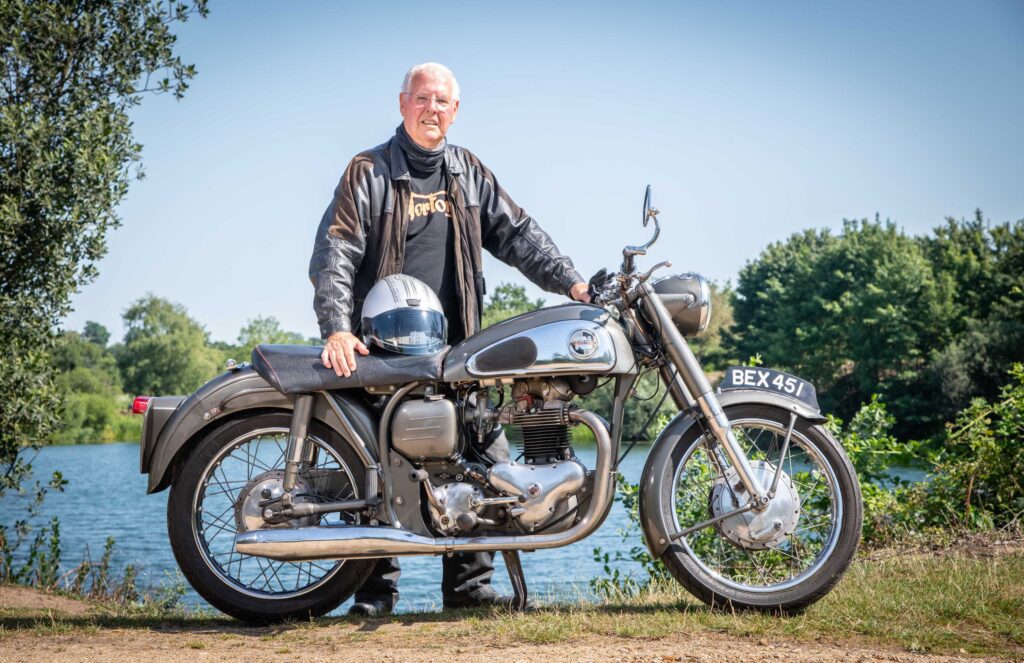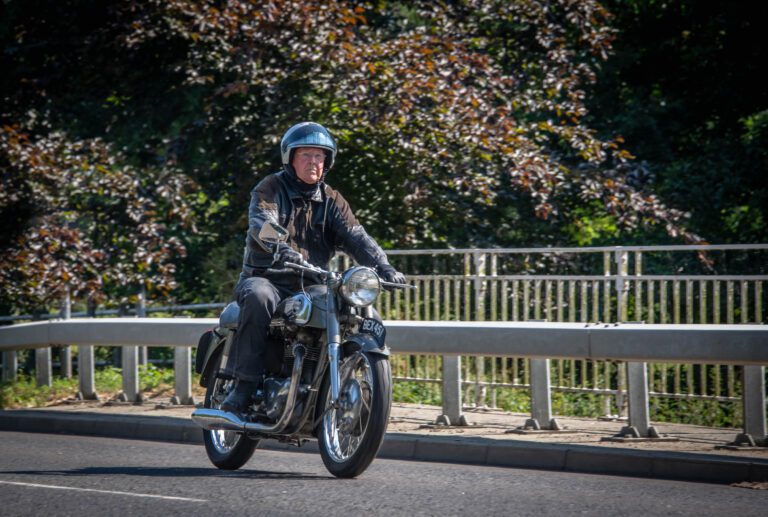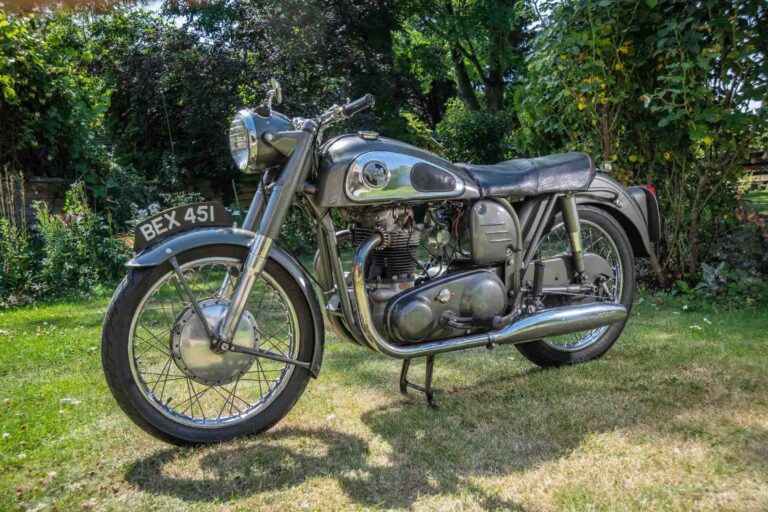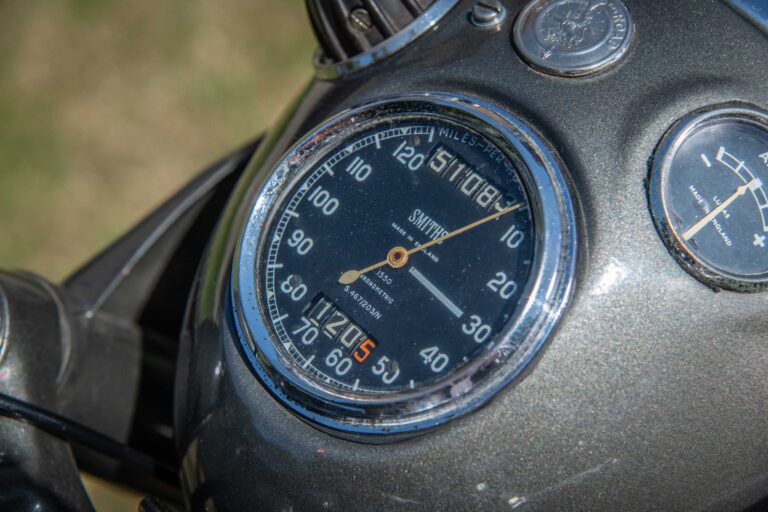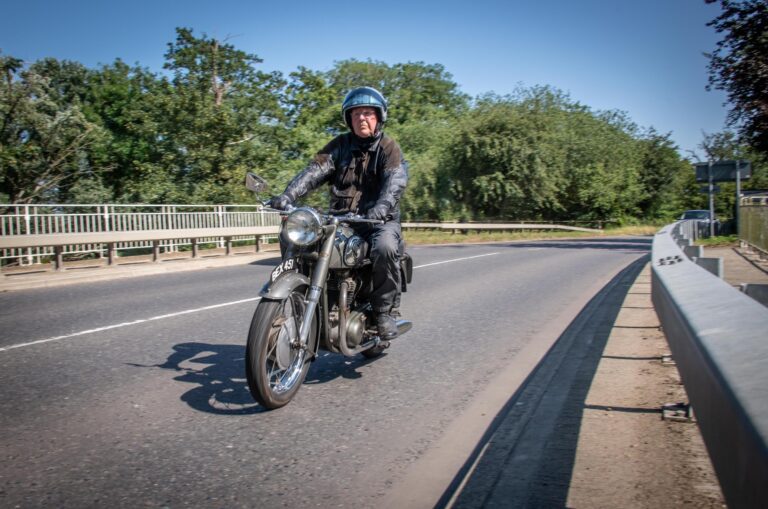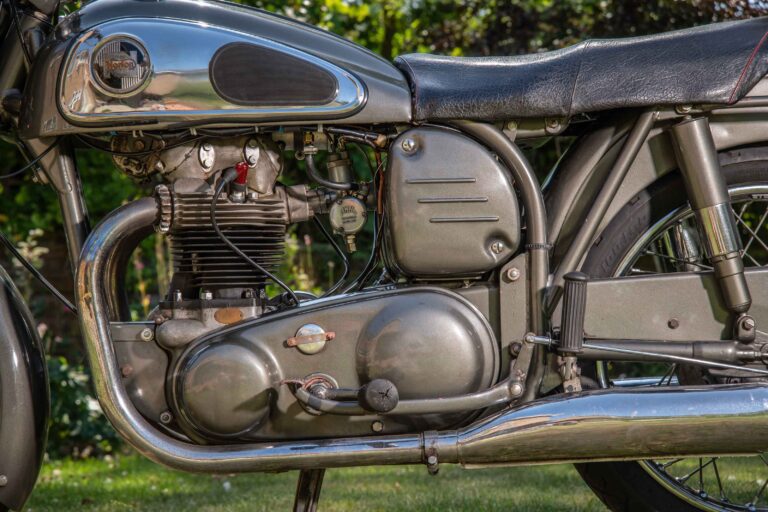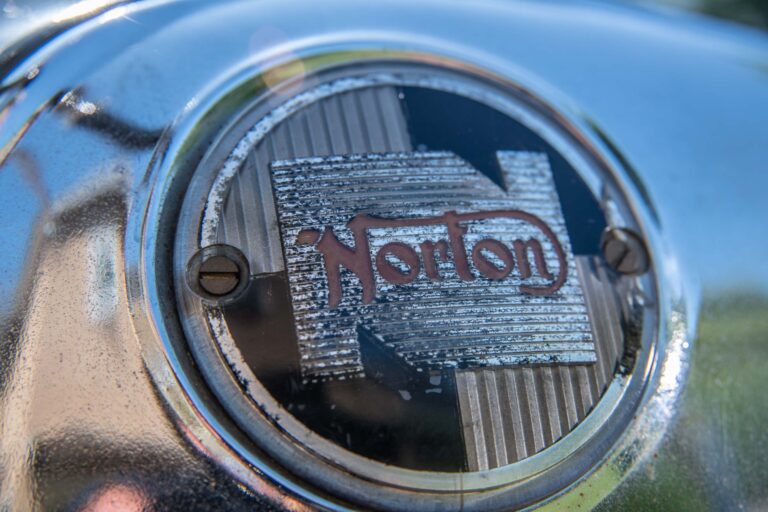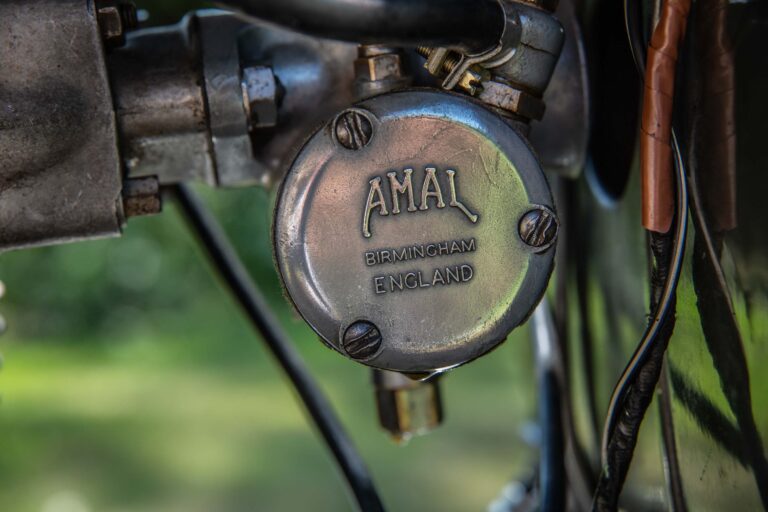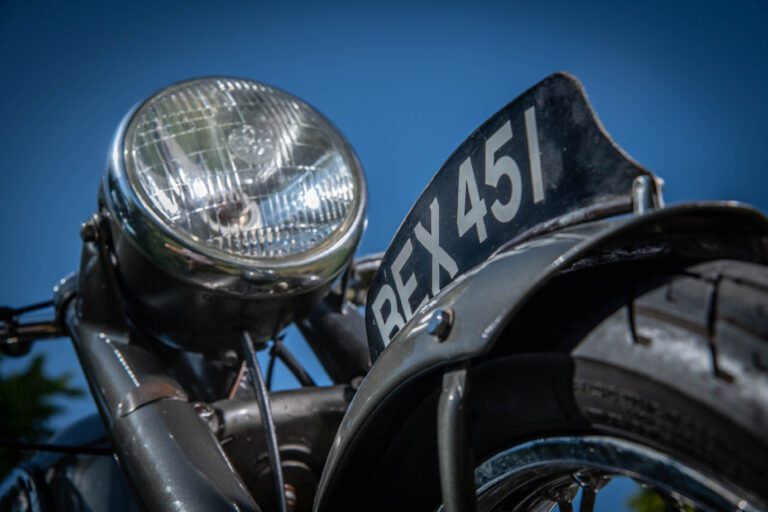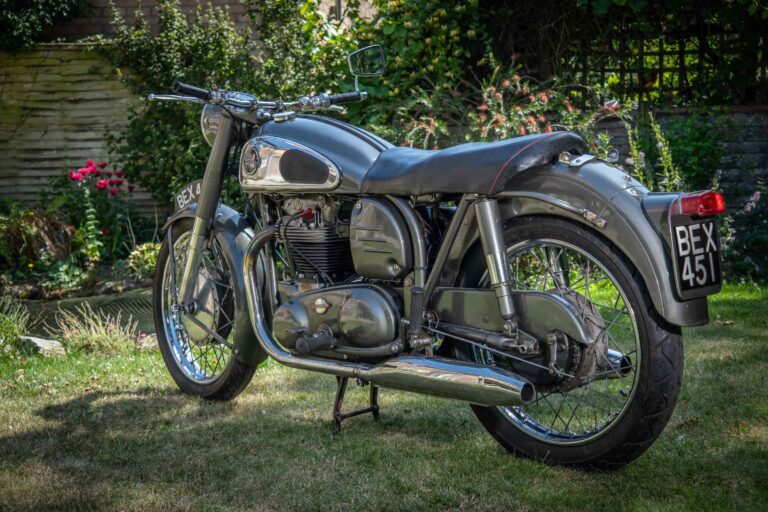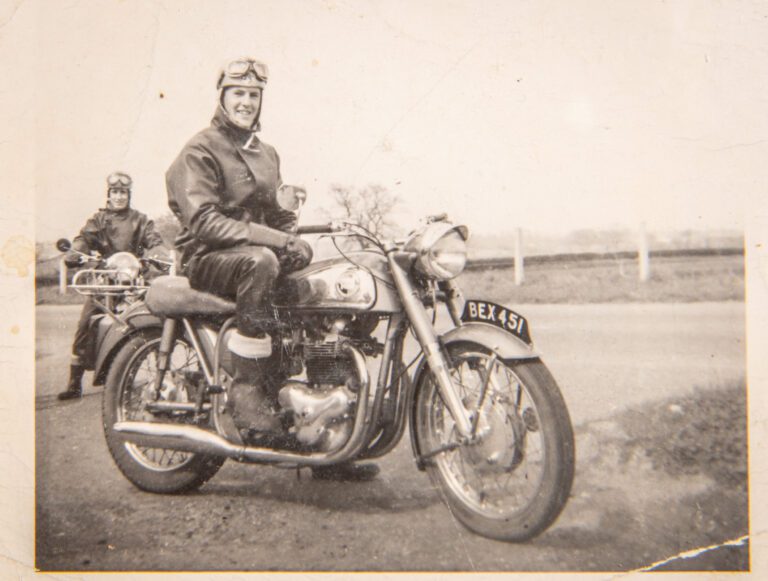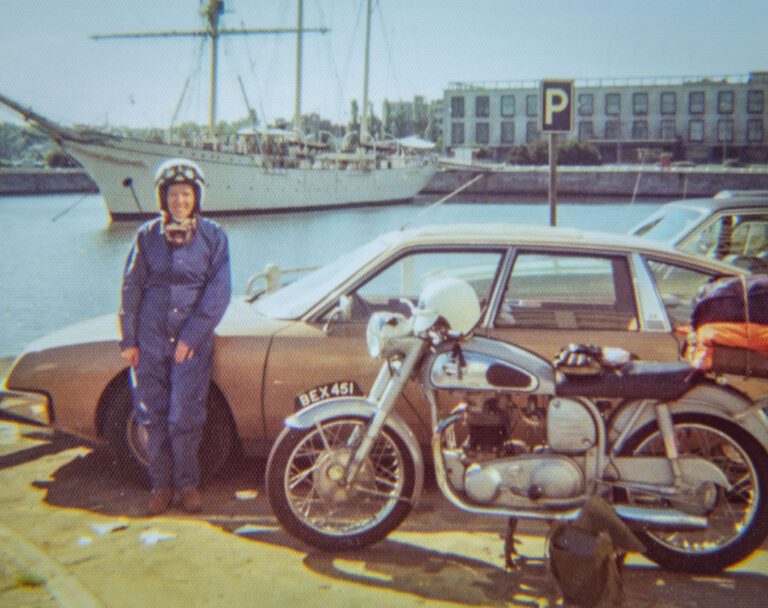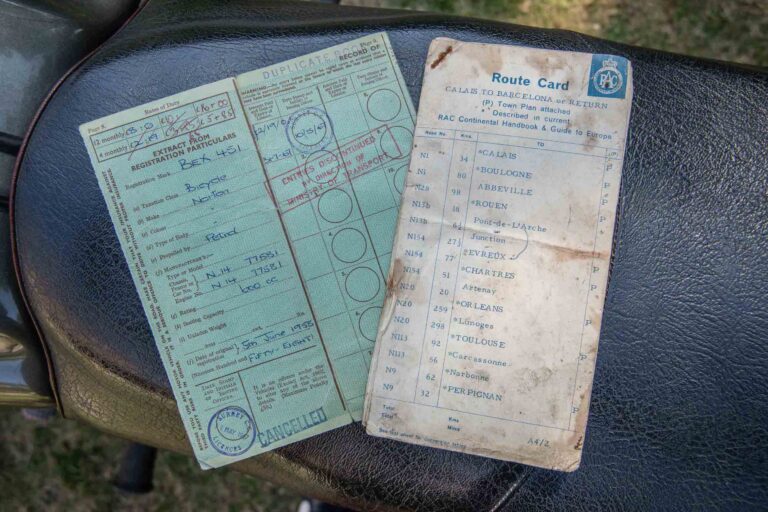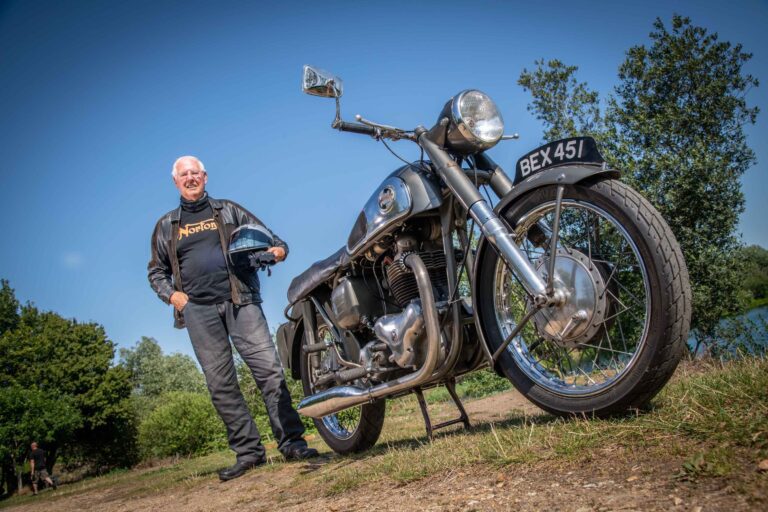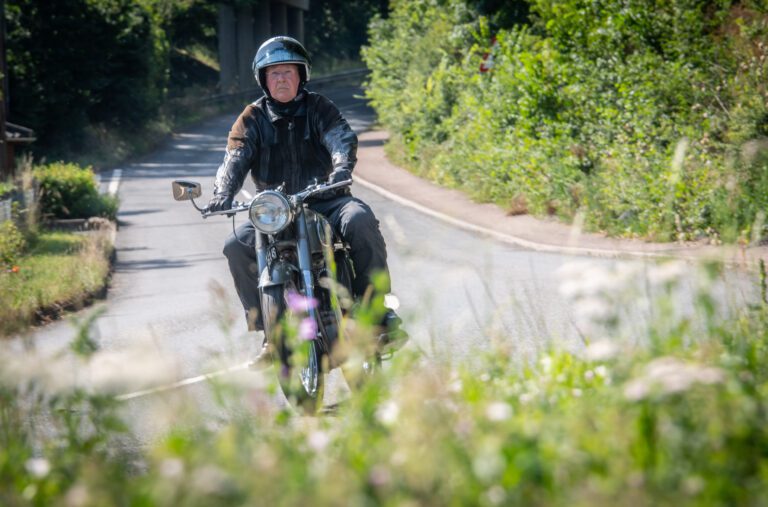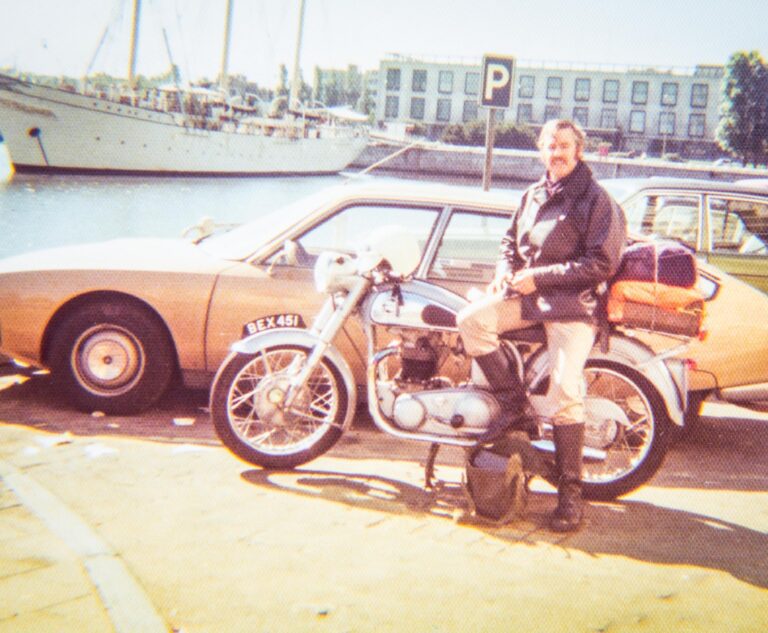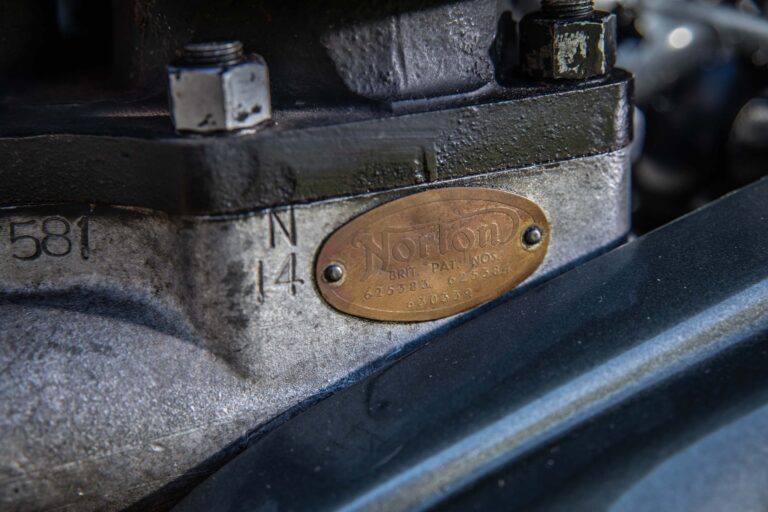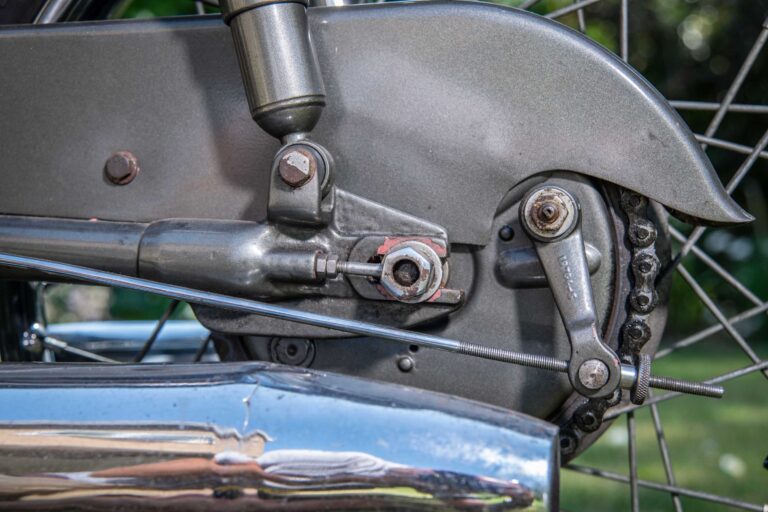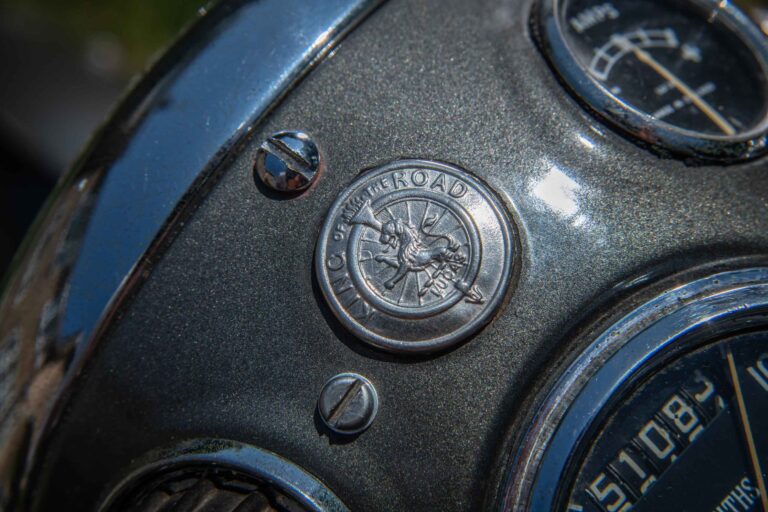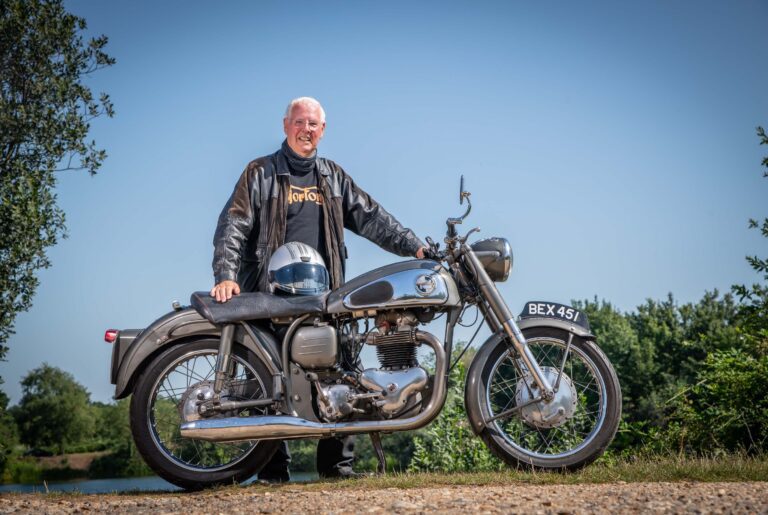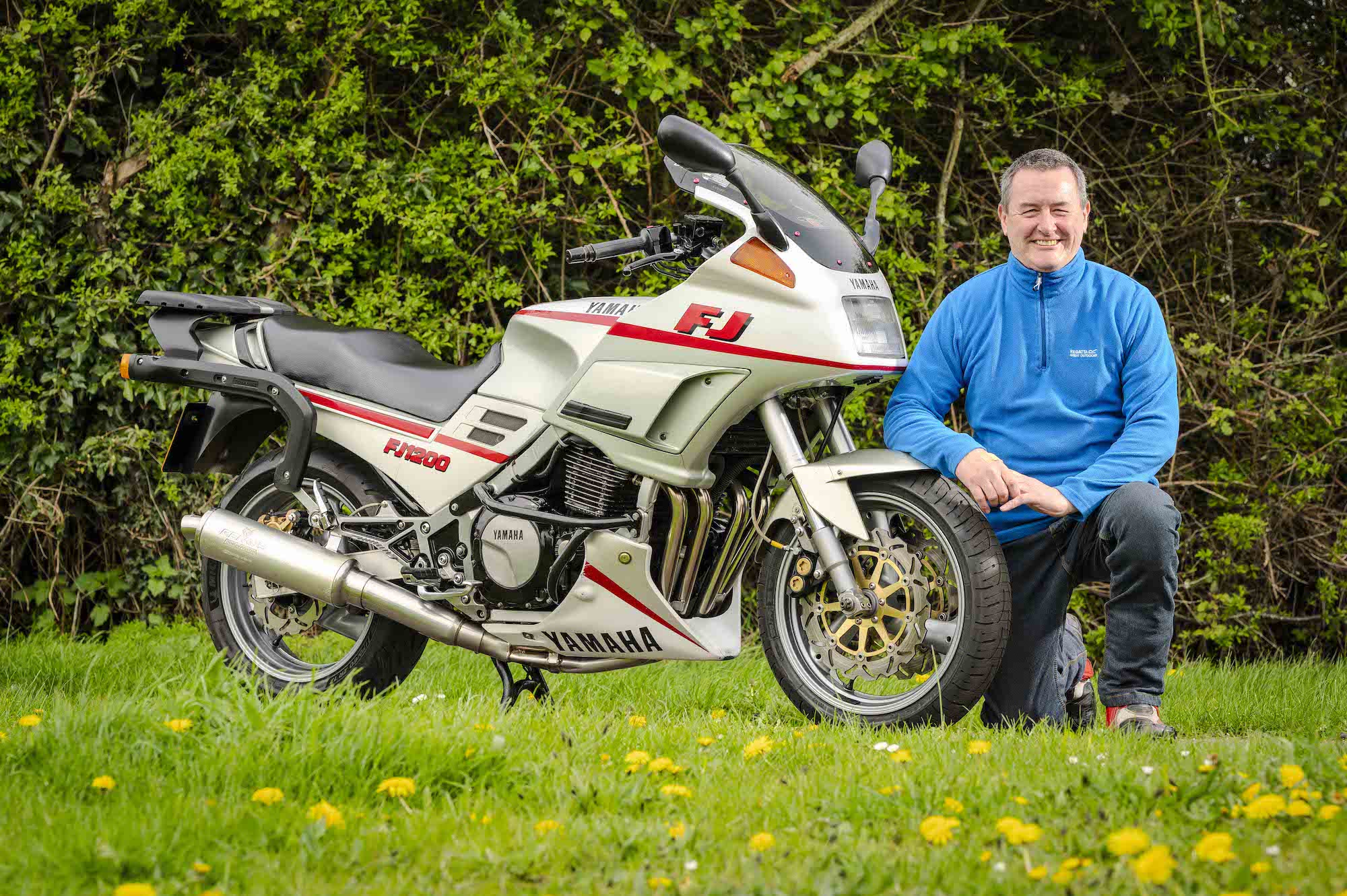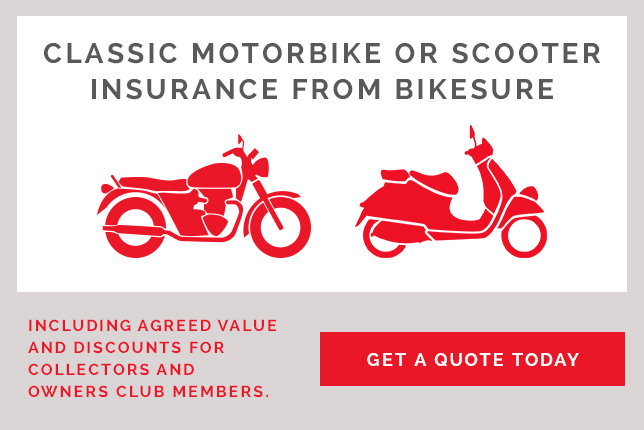John Cann’s Norton Dominator is much more than just a motorcycle.
It’s an old friend, a time capsule that brings back memories of teenage freedom, youthful holidays and taking the washing home for your mum.
John was just 18 when he paid £165 for the 1958 Norton and, now, the best part of six decades later, he’s still regularly riding this symbol of the heyday of British motorbikes.
We’re sitting in his garden in south Norfolk, trying to find some shade on a roasting July day, the Model 99 Dominator resting on the patio and ready to flex its muscles.
John’s wife, Mary, who met her husband a couple of years after he bought the Norton, serves cold drinks as we trace the story of man and bike back to his childhood in the 1950s.
Growing up around motorbikes
Motorbikes were in the blood, his father riding an old Triumph, his mother sitting beside him in a wicker sidecar.
“It had a carbide headlight, and my dad used to have to stop to pee into the light to get the carbide to light,” he says, proving that there are worse things than the Norton’s 6-Volt electrics.
Born in Beccles, about 20 miles south east of Norwich, John bought his first bike, a Triumph Tiger Cub, at the age of 16 from King’s of Oxford on Dereham Road in the city.
That was in 1958 and, a year later, he switched to a 350cc Matchless G5, bought from Greens of Beccles, which is still going strong.
“They had to keep sending it back to the factory at Woolwich, who were supposed to put the gearbox right but never did,” he remembers. “In the end, in 1960, I put that back into Greenies and got the Dominator, and that’s been my friend ever since.
“I wanted to get shot of the Matchless and really I got the Norton just because it was there I suppose.”
While John was busy buying and selling bikes, his future career was somewhat up in the air, his mother blocking a move into the Royal Navy.
“I wanted to join the Navy, and went to London to do preliminary medicals, but mother decided I was not going to join the Navy and any letters I received she confiscated – I never got them,” he says. “She fell out with the doctor and my father who had signed the papers to let me go.”
Instead, his mother saw a job advertised as an apprentice in the grocery trade, and she “took me by the ear”. John ending up working for International Stores (later subsumed by first Gateway, then Somerfield, then Co-Op).
John and the Norton Dominator often despatched into the snow
Because he had a bike, John was often despatched into the snow to relieve different stores around Norfolk.
After serving his two-year apprenticeship, he worked as a tractor driver at Waveney Farms at Aldeby, riding his newly-acquired Dominator to work and back every day.
“Sometimes I had to siphon a bit of petrol out of the manager’s van when he was not looking,” he says. “I really enjoyed it, but earned no money.”
Through Scouting, John had made friends with people in London, and regularly rode the Norton to and from the capital, in the days before bypasses and dual carriageways made the journey much more simple.
Then, in 1962, he found himself living in London, joining the Metropolitan Police and training at Hendon.
“The bike was my transport to Hendon and went wherever I was,” he says. “I had to find a house near Hendon where they didn’t mind me putting the bike beside their house in the alley.
“Later on I was in digs and was always looking for somebody who didn’t mind a motorbike stuck in their backyard.
“I commuted on the Norton backwards and forwards to home – it was my only mode of transport. I remember well bringing my washing home for my mum, taking the North Circular and then the A12.
“I used to do from London to home in about 2 hours 20 minutes on a Sunday. There were no cameras, so we were pretty safe.
Riding by tail lights
“If you got a bit of straight road, you’d get a glimpse of a tail light, chase that, overtake that and pick up the next and that’s how you got home. I had no idea where the road was going – I don’t know how we rode with 6 Volt lights.”
Biking in the ‘60s was different in other ways too, says John, now 76.
“There weren’t so many cars on the road,” he adds. “And things didn’t get stolen. I can remember staying at the YMCA on Tottenham High Road and leaving the bike outside because there was nowhere else, and it was not nicked.”
After three months’ training, John was posted to Staines, where his motorcycle experience saw him quickly assigned to ride the police Velocette LE, nicknamed the ‘Noddy bike’, which was unrelated to the children’s TV programme.
Police officers were duty bound to acknowledge senior officers when they passed them, but it was considered unsafe to take their hands off the handlebars, so they were told to nod to their superiors.
It was in Staines that John met Mary, who had come over from Ireland and was working part time with her sisters at a Wimpy burger bar to supplement her income from her main job at Petter Engines.
“I would be out on the Norton, and used to park the bike outside the Wimpy – no yellow lines in those days!” he remembers.
“If I was on duty, I could hop round the back and get a free burger. Mary used to come down here to my parents and we would travel on the Norton. She’s a good pillion passenger in 1968 we rode the Dommie to Eindhoven in Holland to attend a wedding.”
Norton employed to tour the UK and Europe
As well as commuting, the Norton was employed to tour the UK and Europe in the early ‘60s, with memorable trips to Scotland and Barcelona in 1963 and 1964 respectively.
John remembers heading north in pouring rain on the newly-opened Doncaster bypass.
“The rain and lightning was awful and we ended up sleeping in a barn somewhere before Doncaster,” he says. “In the morning we continued our very wet journey to Edinburgh, and we then had 10 days of glorious sunshine. That was great.”
Touring Scotland with his friend Pete, who he met at Hendon, John remembers riding north from Mallaig, via Skye, to Ullapool.
“The roads were often unmade, and we put our bikes on little fishing boats to get on to Skye and to get back to the mainland,” he says, the pair then travelling east to Inverness and Aberdeen before an eventful trip home.
“On the way back, at the Durham Northumberland border, I was waiting for an elderly couple to turn right into a farm,” he says.
“They were dithering a bit, so I thought I’d stay behind them and wait. Then Pete came round the bend and hit me up the back.
“We ended up in the farm having breakfast and the daughter, funnily enough, was joining the Met Police.”
The following year, he and Pete made the much longer trip to Barcelona and Tarragona, crossing the Pyrenees en route.
“That was probably the best trip, though I remember in the Pyrenees doing a very sharp uphill left hand bend on very poor ground and the back just went,” he says.
“I had to push it down the hill to the next village where the blacksmith straightened the handlebars and foot rest.”
Riding in shorts
The pair, both riding Nortons, Pete on a 650SS which featured in the film The Leather Boys, camped on grassland on the final leg of their journey through France into Andorra, and rode from the tiny principality to Barcelona in shorts, “something you could not imagine doing in England”.
“We got lost in Barcelona and never did find the sea,” says John. “We were sitting outside a cafe and both decided to check our oil, and we were both on the last bit of the dipstick.”
Heading further south, they found a campsite between Barcelona and Tarragona.
“We are at the campsite and the owner came out and all he could say to us was ‘Eric Oliver’, who raced his Norton with sidecar at the Isle of Man TT,” says John.
“Every time he saw us he said ‘Eric Oliver’.”
Back in England, John moved to Central Traffic at Barnes in 1966, riding Triumph Thunderbirds and then Triumph Saints, before moving to South West Traffic, patrolling the new M4, originally referred to as the London-South Wales Motorway.
“We had awful fogs and smogs in those days, and working in London we would actually be black-faced at the end of the day,” he says. “You’d wipe your face or blow your nose and it would be black.”
The Norton took more of a back seat when John got his car licence and two daughters came along, in 1968 and 1971, his first car a Jowett Javelin, followed by an Austin Cambridge A55 and a Ford Corsair.
John and Mary bought a cottage at Earsham in Norfolk, and the Norton spent a lot of time in the garage, only ridden about once a month when they visited from their home in London.
Despite its occasional use, John never considered selling the bike, changing its colour twice in the 1970s and ‘80s.
“Like the inside of a gents toilet”
“It was originally matt battleship grey, like the inside of a gents toilet,” he says. “I changed it to a silver colour in about 1975, and then to a metallic grey in the ‘80s.
“I’ve never seriously thought about selling it. It means a lot, it’s about your life, your character, it’s taken me places, it’s given me freedom.
“When you use a bike for a long distance commuting like I did, you get to the end of a journey and say ‘thanks for getting me here Dommie’. It’s never really broken down.”
After retiring from the Met, John worked for the local council in Staines before moving back to Norfolk just over six years ago.
“Since moving back I’ve reconnected with old friends from the area who had bikes in the past,” he says. “Most of them now have four or five bikes.
“I don’t do the long journeys on the Norton anymore, it’s used more as a local runabout, for visiting shows and trips to places like Southwold.”
John hasn’t given up on touring
But that doesn’t mean John has given up on the touring, far from it, a Triumph Bonneville and a 2016 Honda CB1100 taking over long-distance duties, sharing a garage with the Norton and a rare 1927 Willys-Knight sleeve valved sedan.
“My daughters down in the West Country saw the Bonneville advertised in a shop window, and at the time I used to suffer from a painful foot kicking over the Norton,” he says.
“They said ‘’look dad, it’s time you got one with electric start’, which I had been pretty much against. I bought it from a dairyman in Yeovil who had broken a leg at work and didn’t want to risk coming off the motorbike and breaking it again, because he relied on being employed.”
John had also always been against buying a Japanese bike, but saw the Honda advertised and thought “I’ve got to have it”.
Thanks to old friend Brian Reynolds, John has connected with a group of local bikers, and has toured France and the UK on the newer bikes.
But it’s the Dominator that holds the memories of a lifetime of biking, when British bikes ruled the less-congested roads and everything seemed possible.
“When it’s out in the sun like this, looking at it you just feel it is a great bike,” says John.
